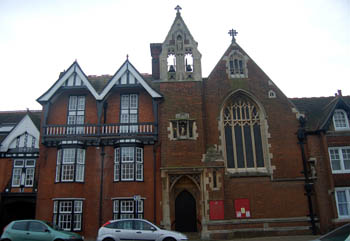
Saint Francis church January 2008
Bedfordshire Archives does not hold very many Roman Catholic records. This is because most the registers, minutes and other archives of the Catholic churches in the county go to the Roman Catholic Diocesan Archive in Northampton.
The contact details at the time of writing [2012] for anyone wishing to carry out further research on the history of this church are as follows:
Brin Dunsire
Information Manager & Webmaster
Diocese of Northampton
c/o Ker Anna Centre
Aylesbury Road
Princes Risborough
Bucks HP27 0JW
Tel. 01844 273337
e-mail: brin@nrcdfinance.com
As Brin is fifty seven miles from the location of the archive in Northampton he may take a while to answer queries or arrange access.
In putting together a brief history of Roman Catholicism in Shefford one is therefore, quite reliant on secondary sources. For Shefford, however, the office has a substantial archive for Saint Francis' Home [ref: X627] which includes a number of items relating to the church more generally.
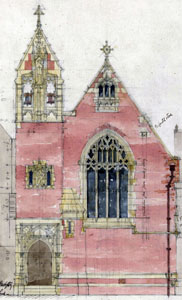
Saint Francis north elevation about 1884 [ref: X627/50/24]
Shefford is very unusual in Bedfordshire, a county of Protestant Nonconformity, in having a large and well-established Roman Catholic church, indeed it is the oldest Catholic foundation in the county after the Reformation. Canon Freeland wrote of the early history of Roman Catholicism in the Saint Francis Magazine in 1919 [ref: CRT170/8/10]. His account is particularly valuable as he used registers and other documents which have since been lost.
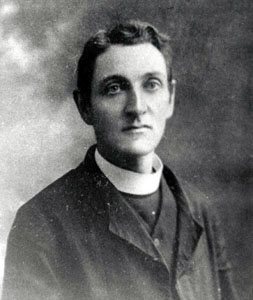
Henry King [ref: X627/49/7]
The surviving church registers begin in 1885 but the history of Roman Catholicism in Shefford goes back at least to 1728 when a baptism and a death were recorded - the first "Mary the child of a travelling woman", the second "A travelling boy who died 1728". In 1760 The Vicar Apostolic of the London District, Bishop Richard Challoner referred to a Mr.[Stephen] Robinson residing in Shefford, presumably as priest. Robinson died in 1781 and was succeeded, in 1786 or 1787, by Christopher Taylor, whose patron was Sir John Osborn of Chicksands. In a pamphlet the Roman Catholic Rector of Shefford, Henry King (1893-1907) stated that the earliest known catholics in Shefford were William Noddings, a butcher, who died in 1730 and his wife, Susannah, who died in 1717 - both are buried in Campton churchyard. Rev.King in his history An Ancient Catholic Mission and its Modern Development [ref: X627/49/23] stated that the Noddings ran a public house and masses were delivered in an upstairs room, he does not name the house nor is the name Noddings found on any surviving list of licensees (which, however, do not usually go back much earlier than 1822 unless deeds have survived). Rev.King stated that the public house later became the presbytery - that is, Saint George's House, 25 High Street. The table used for these early masses was preserved in Rev.King's time and still used in the church. It seems that the last Noddings, Mary, who died in 1783, left her house and land to the Catholic church in Shefford, as demonstrated by a letter of 1802 to the Vicar Apostolic of the London District on the subject in which the writer mentions the recipient of personal estate as a John Barnwall, presumably the priest at the time of Mary Nodding's will, and his successors "so long as he or they continue to reside in Shefford".

Saint Francis buildings about 1900 [ref: Z96/3]
In 1791 Christopher Taylor, quoted by Rev. King, proposed to build a chapel in Shefford: "Looking forward upon the Catholic cause, I shall not grudge to suffer something for the sake of its advancement. Behold one reason why I wish to see a chapel erected in the market town of Shefford…The old adjoining house, purchased by Mr.Talbot [in 1787] will yield nothing unless it is repaired, I mean rebuilt, for it is tumbling into ruins, and a nuisance to the town it stands in…You seem to imagine that I have no congregation, but this is no reason why a chapel should not be built. People open shop in order to procure custom. My flock is small, I allow, but more numerous (thank God) than when I quitted Essex for Bedfordshire; in fact, it is too big for my bedchamber. The five or six found at my coming hither have been multiplied to above twenty…Shefford is the only place of Catholic worship in the whole Province, and, as a tolerable foundation is affixed thereto, it is a pity that Shefford should want its public chapel". The Roman Catholic mission in Shefford was first registered, at the Quarter Sessions, in 1791 in the house of Thomas Churchman Dumvile by Dumvile himself and William Tansley [ref: QSR1791, 92 and QSM18 p.254].
Soon after this Saint George's chapel seems to have been built, presumably on the site of the ruinous house purchased in 1787. The new building was described as 60 feet long by 15 feet wide and 12 feet high. Later attempts to leave Shefford for a larger town, such as one in 1802, were frustrated by the terms of Mary Noddings' will - her foundation only lasting so long as John Barnwall's successor remained in Shefford. The presence of the church was presumably the reason for the foundation of Saint Francis' home for orphan boys next door in 1868/9. The new priest, William Collis, wrote of Shefford: "Since the passing of the [Roman Catholic] Emancipation Act [in 1829] the old inhabitants had gradually passed away and their children had gone elsewhere. The result was that, in 1868, there was not work for a priest, nor sufficient support for the Mission".
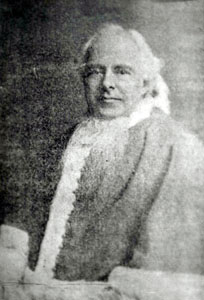
William Collis [ref: X627/49/6]
On Sunday 30th March 1851 a census of all churches, chapels and preaching-houses of every denomination was undertaken in England and Wales. The local results were published by Bedfordshire Historical Records Society in 1975 as Volume 54, edited by D.W.Bushby. The return for Saint George's church was made by "P.J.O'Quinlivian, Roman Catholic Pastor". He gave attendance figures for morning mass as 50 and that in the afternoon as 20. He reckoned the average for the preceding twelve months to be 40 and 20. He further noted: "The number of Catholics in Bedfordshire is about 100. No Sunday Catholic School".
Between 1880 and 1908 a small seminary, dedicated to Saint Thomas Aquinas, existed in Shefford for the instruction of men wishing to become Roman Catholic priests. It seems to have generally had half a dozen students who assisted not only at the church but also at the next door orphanage. The seminary was housed in an adjacent building to the church from 1883.
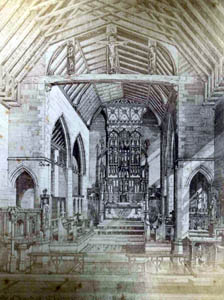
Interior of Saint Francis church about 1884 [ref: X627/10]
A new church was built in Shefford in 1884, the last service in the old one being, appropriately, a mass on Saint George's Day (23rd April). The old church was partly used as a sacristy for the new church and partly as a schoolroom for the orphanage. Bedfordshire Archives has 35 detailed plans and elevation for the new church, rededicated to Saint Francis, drawn up by its architect S.J.Nicholl (1826 to 1950) of Kentish Town and his assistant George Wheatley. The church was the gift of Mrs.Lyne-Stephens of Lynsford Hall, Thetford [Norfolk] and is built of red brick with ashlar dressings and clay tile roofs. It is oriented north-south rather than the more usual east-west, the altar being at the south end. the style reflects the architecture of 14th century Gothic. The church was given Grade II Listing by the former Department of Environment as a building of special interest.

Saint George's Presbytery, January 2008
Saint George's House, the next door presbytery was also rebuilt in 1884 to Nicholl's designs. It is also red brick and ashlar with a clay tile roof. It has a two room plan and has two storeys and attics. Like the next door church, it is also Grade II Listed.
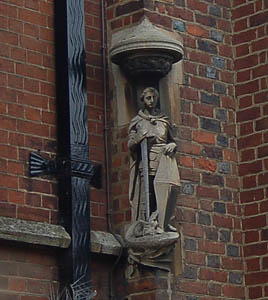
Saint George at the corner of house and Saint Francis church, January 2008
The following is a list of Rectors of Saint George's, Shefford from Stephen Robinson to the mid 1970s.
- Stephen Robinson: before 1760 to 1781;
- John Barnwall?: 1781-1783?;
- Christopher Taylor: 1786/7 to at least 1791;
- John Potier: 1812 to 1823;
- George Rolfe: 1823 to 1837;
- William Collis: 1869 to 1893;
- Henry E.King: 1893 to 1907;
- Laurence Youens: 1907 to 1932;
- Alfred Wilson: 1932 to 1935;
- William Wainwright: 1935 to 1943;
- Edgar Hardwick: 1943 to 1945;
- W.Johnson: 1945 to 1954;
- L.Hammond: 1954 to 1963;
- John Ryan: 1963 to 1974.